Kevin DeYoung's Blog, page 8
May 29, 2020
Revelation, Coronavirus, and the Mark of the Beast: How Should Christians Read the Bible’s Most Fascinating Book? (Part 2)
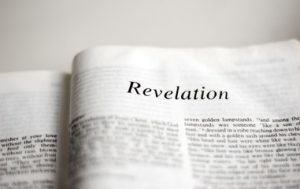
Earlier in the week I started a three-part series on how to read the book of Revelation. We will get to the mark of the beast next week, but first, an explanation of what Revelation says about itself.
You can tell a lot about a book by its introduction. Read the first few sentences of a fairy tale, a memoir, or a logic textbook, and you will instinctively know that there are certain “rules” for interpreting these works correctly. A good introduction helps us approach the rest of the book in the right way. That’s what the introduction to Revelation does. It orients us to the type of literature we are about to encounter.
In particular, the first three verses of Revelation tell us three important things about the type of book we are reading. Revelation is an apocalypse, a prophecy, and a letter.
Apocalypse
The word “revelation” is simply the English translation of the Greek word apokalupsis found at the beginning of verse 1. The book of Revelation is about the uncovering or the unveiling of what must soon take place. To be sure, in some ways, this is a mysterious and difficult book. But we must remember, Revelation is not meant to shroud the truth but to reveal it. God means for us to understand this book.
“Apocalyptic” can sound like an intimidating word, but all we need to understand that as an apocalypse, Revelation is a book of showing. That’s what makes it so intriguing and so tricky. The book doesn’t give us precise legal codes; it gives us verbal pictures. “The revelation of Jesus Christ, which God gave him [Jesus] to show to his servants the things that must soon take place” (Rev. 1:1). It’s important to note that John doesn’t draw us a picture of what he saw or act it out in a play. He expects his visions to be read and heard. We are still dealing with text. But don’t look past the obvious: Revelation is a book of showing. The verb “to see” appears 52 times in Revelation. We are meant to “see” what we read on the pages.
We should look at the visions of Revelation as we would look at portraits in an art gallery. Revelation is not given as sequential clips from a movie, but as self-contained portraits that often show the same thing in a different way. The word most scholars use is “recapitulation.” It means that Revelation is not a chronological road map from chapters 4 to 22, but a series of visions that overlap and repeat. The seven seals are a portrait, and the seven trumpets are another portrait, but they do not necessarily follow one after the other.
Let me see if I can explain this recapitulation better by giving you some examples. Look at Revelation 11:15-18. It’s clearly a picture of final judgment for all people, the righteous and the wicked, the small and the great. Compare these verses with Revelation 20:11-15, which is clearly another picture of final judgment. It will be difficult to make sense of these sections if we think one follows chronologically after the other. We aren’t watching a movie unfold in real time; we are looking at different portraits of the same reality.
You could also look at Revelation 16:17 where the seventh angel pours out his bowl and says, “It is done!” Then in 21:6, he who sits on the throne says, “It is done!” If chapter 21 occurs temporally after chapter 16, we are left with a lot of confusion. God declares “It is done” in two different places. But if Revelation is full of recapitulation, this is not a problem.
Here is one more pair of verses: Revelation 6:12-17 and 16:18-20. In both sections we encounter the day of God’s wrath with a cataclysmic earthquake, islands fleeing, and mountains removed from their place. How can the earth crumble to pieces two times? It doesn’t. But in Revelation, we often have two different portraits of the same event.
We can’t read Revelation like every other book. Revelation is a book of symbols in motion. The graphic images and pictures (given with words) point to a deeper reality. The seven stars are angels, and the seven lampstands are seven churches (1:20). The seven heads are seven hills (17:9). The prostitute is a great city (17:18). Fine linen stands for the righteous acts of the saints (19:8). The ancient serpent is the Devil (20:2). Unless we are prepared to look at Revelation symbolically—in pictures—we will miss the point.
Because Revelation is a showing book, full of symbols, numbers play a crucial role. John doesn’t use numbers as secret codes to crack but as signs of completeness, totality, and perfection (or the lack thereof). Three numbers are particularly important: seven, four, and twelve.
Seven is the number of completeness, especially in a spiritual sense. Thus, John writes to seven churches (real churches) as a representation of all churches. Likewise, we see seven spirits, seven judgments (in the seals, trumpets, and bowls), and seven lamps. The phrase “Lord God Almighty” occurs seven times (1:8; 4:8; 11:17; 15:3; 16:7; 19:6; 21:22), as does the phrase “the one who sits on the throne” (4:9; 5:1, 7, 13; 6:16; 7:15; 21:5) and the word “Christ” (1:1, 2, 5; 11:15; 12:10; 20:4, 6). Prophecy is mentioned seven times (1:3; 11:6; 19:10; 22:7, 10, 18, 19). Peoples, tribes, languages, and nations are mentioned seven times (5:9; 7:9; 10:11; 11:9; 13:7; 14:6; 17:15). The Spirit/Holy Spirit is mentioned seven times in relation to the seven churches and another seven times in the rest of the book (1:10; 4:2; 14:3; 17:3; 19:10; 21:10; 22:17). Jesus is used 14 times (7 x 2), and Christ is called the Lamb twenty-eight times (7 x 4).
The number four points to universality or worldwide scope. That’s why we read of four living creatures, four horsemen, the four corners of the earth, the four winds, and the four-fold phrase “people, tribe, language, and nation.” Similarly, the phrase “the one who lives forever” appears four times (4:9, 10; 10:6; 15:7) as does “seven spirits” (1:4; 3:1; 4:5; 5:6) and references to lightning, sounds, and thunder from the throne (4:5; 8:5; 11:19; 16:18).
The number 12 and its multiples indicate the fullness of God’s people. Hence, we have 12 tribes and 12 apostles. We read of 24 (12 x 2) thrones and 24 elders. We see God’s people symbolically depicted as 144,000 (12 x 12 x 1000). And in the depiction of the New Jerusalem where God’s people dwell for all eternity, the number 12 occurs 12 times.
You get the picture (pun intended). Revelation, as an apocalypse, is a book of symbols and a book of showing.
Prophecy
Revelation is also a prophecy (1:3; 22:7), and as such, it’s rooted in Old Testament imagery. We will misread Revelation if we try to find referents from our day instead of first of all seeing allusions from the Old Testament. Think of all the Old Testament imagery that Revelation borrows: the tree of life, the ancient serpent, the plagues, the Song of Moses, Jezebel, Babylon, the temple, Jerusalem, the 12 tribes of Israel, priests, incense, Balaam, the water of life, the winepress of God’s wrath, and on and on and on. Even though Revelation is about the future, it, more than any other book in the New Testament, only makes sense when seen through the eyes of the past. A list of Old Testament allusions and parallels in Revelation would fill several pages, with around 500 references.
Moreover, Revelation is not just steeped in Old Testament imagery, it is the fulfillment of Old Testament prophecy. Think, for example, of the connection between Revelation and the book of Daniel. In Daniel 2 Daniel interprets a dream for King Nebuchadnezzar. In his dream Nebuchadnezzar sees a large statue made of gold, silver, iron, and clay. The statue is broken to pieces by a rock that then becomes a huge mountain that fills the whole earth. The four metals are four kingdoms, and the rock is a final kingdom set up by God that will destroy all the other kingdoms and never be destroyed. In Daniel 2:28 Daniel says, “God has shown King Nebuchadnezzar what will happen in days to come.” And in verse 29 he says, “The revealer of mysteries showed you what is going to happen.” This language is similar, and identical in parts, to the language used in Revelation 1:1, except this time John speaks of a revelation that God gave to show what must soon take place. The phrase “what must soon take place” is used four times in Revelation, and the connection with Daniel is deliberate. What Daniel interpreted as going to happen in latter days is now close and even at hand. The appointed time when God would set up his divine everlasting kingdom—that rock that destroyed the statue of gold, silver, iron, and clay—has arrived.
Let me highlight one more connection, this time between the end of Daniel and the end of Revelation. In Daniel 12:4 Daniel is told, “But you, Daniel, close up and seal the words of the scroll until the time of the end.” In Revelation 22:10 John is told, “Do not seal up the words of the prophecy of this book, because the time is near.” You can hear the similar language. But, whereas Daniel was told to seal it up until the end, John was told to keep it open, because the time is near. What Daniel saw was coming to culmination in John’s day. What had been far off was now near at hand.
This means we are in the end times/last days and have been for years (cf. Acts 2:17; 1 Tim. 4:1). This doesn’t mean the end of the world is tomorrow. The “end times” or the “last days” is the designation for the time following the triumph of Jesus Christ on the cross. A new day has dawned in salvation history. That’s the point of the connections between Daniel and Revelation. The divine kingdom that would destroy all other kingdoms has already come—it is at hand. But it is not yet fully established. The prophecy of Daniel and the whole Old Testament, really, has come to its zenith in Revelation. The triumph of the Son of Man, the coming of the divine kingdom, and the salvation of the righteous, and the judgment of the wicked have already occurred, and they are not yet completed. In other words, the time that John saw as soon to appear has not been fully realized, but it has been inaugurated.
If all this sounds confusing, it’s because most of us don’t understand how multi-layered biblical prophecy is. Most prophecy in the Bible works by speaking to the immediate context and spinning out into the future. Most prophecy has an already and not-yet fulfillment.
For example, Isaiah 40:3-5 says, “A voice of one calling: In the desert prepare the way for the LORD; make straight in the wilderness a highway for our God. Every valley shall be raised up, every mountain and hill made low; the rough ground shall become level, the rugged places a plain. And the glory of the LORD will be revealed, and all mankind together will see it.” What is Isaiah talking about? Well, he’s talking about the return from exile in Babylon, but he’s also thinking of a deliverance more complete. Therefore, when the Gospels see in John the Baptist the fulfillment of Isaiah 40, they aren’t making things up. They are seeing the fulfillment of God’s ultimate salvation. The New Testament writers understood—as the Old Testament prophets did—that prophecy usually has a near-term and long-term fulfillment.
It’s as if a prophet came to America after 9-11 and said, “Hear, O my people, in America. Your days of fear will soon be over. I will topple Hussein. Bin Laden will I find out. Baghdad will be a haunt of jackals and Al-Qaeda a wasteland. No more will terror strike your land. Mothers will no longer weep. Children will not be fatherless. I will deliver you from all your sorrows. Death shall be destroyed, and your punishment ended. I will be among you always. I am the Lord your God, and there is no other.” Obviously, that’s not a real prophecy. But since it deals with familiar people and places, we can more easily hear near-term and long-term fulfillment. My made-up prophecy speaks hope into the immediate context, but the language is also so exalted and otherworldly as to point us to a later, fuller fulfillment. That’s how prophecy worked in the Old Testament and how it is fulfilled in Revelation.
Letter
Revelation is an apocalypse, a prophecy, and a letter. It is a letter written by John and sent to seven real churches. Some of the churches were under attack: spiritually, physically, and materially. And some of the churches were knee-deep in compromise and worldliness. The message that this letter conveyed was, above almost all else, an exhortation to overcome. “Don’t give up. Don’t give in. Jesus has won the victory. Live like him. Die like him. But do not succumb to the devil and the world.”
Revelation was probably a circular letter meant to be read at one church and then sent on to the next. Revelation would be read in a worship service, probably in one sitting. Much of the congregation would have been illiterate. They couldn’t have studied the letter even if they had a copy, so the church would listen as the reader read.
You might think, But how could they possibly understand a book like this? They didn’t have commentaries, or concordances, or Bible software, or inductive training methods, or even a Bible to follow along in! But they did have several advantages we don’t have.
First, they didn’t have TVs, movies, and the internet, so they were probably just plain better at learning with their ears.
Second, they probably knew the Old Testament better than we do.
Third, they didn’t need a translation.
Fourth, they lived in the world and culture in which the letter was written. That’s a huge advantage. No matter how brilliant and diligent our study, we will never be able to know the world of first-century Asia Minor as well as the people who lived in it. I’m sure there were all sorts of idioms, symbolisms, and referents that we struggle to uncover that they would have known instantly. We have to read big fat books to figure these things out, but things would have been much clearer had you been sitting in the First Church of Smyrna.
This isn’t to make us despair of understanding Revelation. With a good knowledge of the Old Testament and some historical knowledge, we can understand this book. After all, God gave it to us to show his servants what must soon take place. The point I am trying to reinforce is that we must not forget Revelation was a real letter to real people. It was written for a first-century audience. Now, it still has significance for us, but it was first of all written to seven churches in Asia Minor who lived in the first century, understood Greek, and were threatened by persecution and tempted to compromise. While it’s quite possible for Revelation to signify more than first-century Christians could fully understand, it must never mean less. As a letter, our interpretations of Revelation must be constrained by John’s authorial intent and the original audience’s ability to make sense of what was written.
May 26, 2020
Revelation, Coronavirus, and the Mark of the Beast: How Should Christians Read the Bible’s Most Fascinating Book? (Part 1)

Whenever there is a cataclysmic global crisis—be it war, rumors of war, or a novel coronavirus—we see a sharp uptick of interest in the book of Revelation. While paying attention to the Bible is always a good thing, Revelation is too often used (by Christians and non-Christians) in a way that does less to edify the body of Christ and more to stoke the fires of wild speculation and unfounded conspiracy theories.
It may be helpful, then, to understand what kind of book Revelation is and how to make sense of imagery like the mark of the beast. We’ll get to the mark of the beast in the third and final installment of this short series. But before we get there I want to take a couple posts to look at what Revelation is all about and how we should interpret this not-as-strange-as-it-seems book.
Big Picture
Probably no book of the Bible has been harder for Christians to understand and, as a result, produced more bizarre theology than the book of Revelation. Although it is called “revelation,” it has been anything but a revelation for many Christians. It is a closed book for many of us, not correcting, not teaching, not rebuking, not training in righteousness like all Scripture should.
I remember teaching through part of Revelation for a Sunday school class several years ago and telling my mom about it over the phone. She said something like, “Kevin, you’re not going act like you have everything figured out are you? John Calvin didn’t even write a commentary on Revelation. You don’t know more than John Calvin, do you?” It is true that Calvin did not write a commentary on Revelation (one of the few books he didn’t write on), and it’s true that I don’t have everything figured out. But most of Revelation can be understood and applied if we will take the time to study it.
In fact, the entire book of Revelation can be summed up in one word: nike. Nike is the Greek word for victory. It occurs one time in the New Testament—1 John 5:4 states, “This is the victory that has overcome the world, even our faith.” Another form of the word (nikos) appears four other times, three times in 1 Corinthians 15 (e.g., “Death has been swallowed up in victory;” “He gives us the victory through our Lord Jesus Christ”). The verb form, nikao (meaning to conquer, to overcome, to triumph), occurs more frequently—28 times. Seventeen of those occurrences, more than in the rest of the New Testament combined, are in Revelation.
Revelation is the story of the Devil trying to conquer the church, but the church overcomes the Devil and the world because she belongs to the Lord who has won for us the victory (Rev. 5:5; 17:14). The book of Revelation gives instruction for the believer on how to conquer instead of being conquered, how to triumph instead of being trampled, and how to be an overcomer instead of a succumber. That’s why each of the seven letters to the seven churches concludes with “to the one who conquers . . .” If we cave and give in to persecution and give into worldliness and give into the Devil’s temptations, we will lose. But if we overcome through trial and suffering and seeming irrelevance, we will win (Rev. 21:6-7). That’s where history is heading, and that’s the big idea of Revelation.
(Possible) Map for the (Seeming) Madness
There is no one inspired way to understand the structure of Revelation. When studying this book in-depth several years ago, I found 11 different outlines, which suggests there probably isn’t one obvious structure we’re supposed to see.
One simple approach is to see Revelation as divided into two main sections. Chapters 1-11 introduce the story of God’s triumph, and chapters 12-22 explain the story in greater detail, this time unveiling in more depth the role of evil through the beast, the false prophet, and the whore of Babylon.
Another way of approaching the book is to divide it into four main sections, each marked off by the phrase “what must soon take place” or “what must take place after this.”
Rev. 1:1 The revelation of Jesus Christ, which God gave him to show his servants the things that must soon take place.
Rev. 1:19 Write therefore the things that you have seen, those that are and those that are to take place after this.
Rev. 4:1 “Come up here, and I will show you what must take place after this.”
Rev. 22:6 “And the Lord, the God of the spirits of the prophets, has sent his angel to show his servants what must soon take place.”
The language in these four passages comes from Daniel 2 and indicates that Old Testament prophecy is already and not yet completed in Revelation.
There’s another way to outline the book into four main sections. This approach marks out the times John says he was caught up in the Spirit.
Rev. 1:10 I was in the Spirit on the Lord’s Day, and I heard behind me a loud voice like a trumpet.
Rev. 4:2 At once I was in the Spirit, and behold, a throne stood in heaven, with one seated on the throne.
Rev. 17:3 And he carried me away in the Spirit into a wilderness.
Rev. 21:10 And he carried me away in the Spirit to a great, high mountain, and showed me the holy city Jerusalem coming down out of heaven from God.
By this reckoning, Revelation consists of four main visions that John saw while he was in the Spirit on four different occasions.
Yet one more way of approaching the book—and the approaches are not mutually exclusive—is to look for sets of sevens. Everyone recognizes that seven is a crucial number in Revelation, and that there are at least four sets of sevens: seven letters, seven seals, seven trumpets, and seven bowls. This much everyone agrees on. But from here things get less clear. Since there are plainly at least four sets of sevens, many scholars have wondered if we are meant to see seven sets of sevens. I am convinced there are seven sets of sevens, but I certainly wouldn’t be dogmatic about it. My outline, which is similar to outlines I’ve seen from others, looks like this:
Prologue: 1:1-8
I. Seven letters: 1:9-3:22
II. Seven seals: 4:1-8:5
III. Seven trumpets: 8:6-11:19
IV. Seven visions: 12:1-15:4
V. Seven bowls: 15:5-16:21
VI. Seven judgments: 17:1-19:10
VII. Seven last things: 19:11-21:8
VIII. The beautiful bride: 21:9-22:21
You’ll notice there is an eighth section that is not a set of seven. An eighth section makes sense because eight is often the number of new creation in the Bible (Jesus rose on the eighth day/first day of a new week, eight people started the new humanity after the flood, sons were to be circumcised on the eighth day), and this eighth section is about the new heavens and new earth. But there is nothing inspired about the outline above. It’s just one way of making the book more manageable and putting together some possible patterns with some obvious ones.
Our Interpretive Lens
The last thing I want to do in this post is look at the various ways Christians have understood Revelation. There are four main schools of thought.
The first school of interpretation is called preterism. The preterist approach teaches that a large portion of the book of Revelation was fulfilled in the first century, specifically in the destruction of the temple in AD 70. Further, most of the prophecies in Revelation were fulfilled by the fall of the Roman Empire in the fifth century.
The strength of the preterist school is that it puts Revelation in its original context. Revelation was written to first-century Christians with first-century metaphors and imagery and referents. If we jump to the 21st century and ask, “What does this mean for me?,” we will almost surely get the wrong answer. We have to first ask, “What did this mean to them, to John’s original audience?”
Preterism is not without weaknesses. First, some preterists try to find a single, specific fulfillment to the prophecies of Revelation when it seems more likely that John’s visions often portray generalized spiritual battles and struggles that occur throughout the ages. Second, full-blown preterists argue that all of the end-time events, like the second coming and the last judgment, actually were fulfilled by AD 70. This does not seem in keeping with the cataclysmic language used at the end of each sequence.
The second school of interpretation is called historicism. The historicist reads Revelation as a straightforward, sequential roadmap of history. Revelation is seen as predicting any number of key historical figures and events from Napoleon to Hitler to the European Union to the United Nations.
The strength of historicism is that it makes Revelation relevant for all Christians. It focuses our attention not on the fall of the temple or on the Roman Empire but on the way of the church in the world.
But besides this strong point, historicism is the worst way to try to understand Revelation. It is full of weaknesses. Let me quickly mention just four.
First, historicism is often anachronistic and takes Revelation out of its original context. I am thinking of those who argued that the country out of the north (from Daniel, not Revelation) must be Russia, or that the locust swarm from Revelation 9 is foretelling a helicopter battalion. These sorts of interpretations completely ignore the imagery of ancient prophecy and the context of the first century.
Second, historicism, with its end-of-the-world predictions and identifications of the beast, has often been demonstrably wrong. During the cold war, people saw Russia in Revelation. A decade ago they saw Iraq. Now they see the coronavirus. In a few years, they will be on to something else. Historicists tend to see Revelation being fulfilled in whatever crisis is pertinent for the day. And then on another day, another group of historicists see that view was wrong and find something completely different.
Third, historicism limits the prophecies of Revelation to one exclusive location or personality instead of allowing that the imagery of Revelation may be well suited to an inclusive number of different figures and times. That is, I think historicists are right to see Revelation unfolding in history, but they are wrong to think that Revelation is uniquely unfolding in one historical moment.
Fourth, historicism is irreducibly subjective. There is simply no objective standard of interpretation. Who’s to say that Hitler was more the beast than Stalin? Or that 666 is a reference to Bill Clinton (as one website I found argues)? Or, as another article maintains, that Ronald Wilson Reagan (six letters in each of his names!) was the beast? It’s all hopelessly subjective. The text ends up saying anything we want it to.
The third school of interpretation is futurism. The futurist reads Revelation (chs. 4-22) as a prophecy solely concerned with the distant future. The events depicted refer to the time involving, or immediately preceding, the end of history. Dispensationalists are futurists (though not all futurists are dispensationalists).
The strength of futurism is that it emphasizes how Revelation speaks to the future, not just about the past. Futurism is right to see that some things in Revelation deal with the final consummation of human history. Futurists are also right to see that the future is moving somewhere, toward the triumph of the Lamb.
But futurism also has weaknesses.
First, if Revelation 4-22 is entirely and only about the distant future, then most of Revelation was barely relevant to its original readers. Sure, it would have helped them see the end of the world, but it really spoke little into their immediate context (when John says Revelation revealed “what must soon take place”).
Second, futurism often assumes a strict sequential chronology. And yet, we cannot assume that what is shown to us in chapter 12 comes in time after what we see in chapter 6. To the contrary, one of the keys to interpreting Revelation is to understand that its visions are recapitulated. So, Revelation gives us a sweep through history in the seven seals, and then does the sweep again in the seven bowls. Revelation comprises overlapping prophecies that go back and forth between the present and the future and are not strictly chronological.
Don’t think of the visions of Revelation as frames from a movie reel running through the light one after the other. Think of the visions as portraits in a gallery. You look at one portrait and get a glimpse of reality, and then you look at the next portrait, and then you walk over to the next room and look at the portraits over there. They are pictures telling the same story and pointing to the same reality, but they aren’t sequential clips from a movie.
The fourth school of interpretation is idealism. The idealist reads Revelation as a symbolic conflict between the forces of good and evil. Revelation, idealists argue, does not point to particular historical figures but depicts the timeless struggle between God and Satan. It interprets Revelation as a series of repeated symbolic pictures, focusing on the church’s triumphant struggle from the first century until the last judgment and the eternal state.
The strength of idealism is that is understands the symbolic nature of Revelation. It realizes that Revelation’s imagery is rooted first in Old Testament language and second in the known world of the first century. The other strength is that it sees behind the first-century context deeper spiritual realities that would outlive and transcend ancient Rome and remain relevant for believers throughout the ages.
The weakness of idealism is that it can at times under-emphasize the fact that all of history is moving somewhere. That is, idealism sometimes sounds vague, as if there were no end point in history as we know it, as if Revelation was just about the struggle between good and evil and not also about the ultimate triumph of Jesus Christ.
Interpret the Book
So what approach do I think helps us best understand Revelation? I think each approach offers something needed. This doesn’t mean that I think every approach is good or that one is not better than another (I’m basically an idealist with a partial preterist bent). But each school of interpretation does offer something important.
With the preterist, we must read Revelation in its immediate context.
With the idealist, we must look at Revelation as a symbolic portrayal of God’s work, most of which can be applied to any historical time.
With the futurist, we must read Revelation with end of history in mind, recognizing that the book depicts, in parts, the second coming, the final judgment, and the eternal state.
And with the historicist, we must understand that the prophecies of Revelation, though they are not limited to one particular occurrence, are fulfilled in time and space.
The best way to defend one’s interpretive grid is to actually interpret the book. But since this is a three-part blog series and not a 50-part sermon series, we will have to settle for just one more post on the subject. In the first three verses, John makes clear that this book is an apocalypse, a prophecy, and a letter. Once we know what each of the terms entail, we will be better equipped to understand the book as a whole and specific imagery like the mark of the beast.
May 20, 2020
Theological Primer: The Ascension

From time to time I make new entries in this continuing series called “Theological Primer.” The idea is to present big theological concepts in around 500 words. Today we will look at the ascension, as tomorrow marks Ascension Day in the church calendar (the 40th day of Easter), and the next Lord’s Day is Ascension Sunday.
Having triumphed over death and the devil in his resurrection, Christ ascended into heaven locally, visibly, and bodily—locally in that he spatially left earth below for heaven above, visibly in that the disciples saw with their own eyes (as a public event) that he departed from them, and bodily in that the physical flesh of the Son of God is no longer with us on earth.
We can think of Christ’s state of exaltation (as opposed to his state of humiliation) as consisting of four events, each part tracking with a phrase in the Apostles’ Creed: resurrection (he rose again from the dead), ascension (he ascended into heaven), session (and is seated at the right hand of God the Father Almighty), and physical return (from there he will come to judge the living and the dead).
The ascension is more prominent in Scripture than we might realize. Luke describes the ascension in the most detail, first in his Gospel (Luke 24:50-53) and then in Acts (Acts 1:9-11). Peter’s Pentecost sermon on Pentecost is, in part, about the ascension and enthronement of Christ (Acts 2:32-36).
Likewise, John’s Gospel is full of references to the ascension of the Son of Man (John 3:13, 6:62) and the importance of Jesus returning to the Father (John 14:2-3; 16:5). The ascension is not simply how Jesus gets to heaven, it is a further fulfillment and vindication of the triumph of the resurrection (John 16:5; 20:17).
It’s no wonder that the ascension is highlighted throughout the New Testament, as a necessary precursor (1) to the giving of Messianic gifts (Eph. 4:8-10), (2) to the intercession of our High Priest (Heb. 4:14-16), and (3) to the subjection of all things under Christ’s feet (1 Peter 3:22).
What, then, does the oft-overlooked ascension mean for us?
First, the ascension means that we have an advocate with the Father, Jesus Christ the righteous (1 John 2:1; Rom. 8:34).
Second, the ascension means God’s people are, in a manner of speaking, already in heaven. We set our minds on things that are above, because our lives are hidden with Christ who dwells above (Col. 3:2-3).
Third, the ascension means we can receive the gift of the Holy Spirit. Once ascended to heaven, Jesus sent another Helper (John 14:16; 16:7) to give us power from on high and to be with us forever.
Fourth, the ascension means human flesh sits enthroned in heaven. God has granted all power and authority to a man (Matt. 28:19; Eph. 1:21-22). Jesus Christ is exercising the dominion that human beings were made to have from the beginning (Gen. 1:28). The ruin of the first Adam is being undone by the reign of the second.
Because of Christ’s ascension we know that the resurrection is real, the incarnation continues, Christ’s humanity lives on in heaven, the Spirit of Jesus can live in our hearts, and a flesh-and-blood, divine human being rules the universe.
May 12, 2020
Life and Books and Everything

You may have seen that I’ve started a podcast with my good friends Justin Taylor and Collin Hansen. The podcast is called Life and Books and Everything, and in it we talk about everything from coronavirus to pop culture, from food to football, from theology to history, and from Mother’s Day to growing up in the Midwest—but in every episode we spend time talking about books (and also laughing).
For now, the podcast can be found through Christ Covenant’s online channels. You can access Episode 4 through the church website or through Apple Podcasts.
Episode 4 begins with the airing of grievances as we discuss little things that bother us (and speculate about the little things about us that bother other people). We then discuss the perils and pitfalls of social media and how the medium shapes our message. When we come to books, we talk about the books we intentionally re-read and offer book recommendations for preaching and for pastoral ministry. All in all, a good time was had by, well, the three of us.
Previous episodes:
Episode 1 topics covered include introduction of co-hosts, perspective on the ever-changing coronavirus, the death of expertise, planning in a pandemic, what we hope COVID-19 will change, current reads, forthcoming Crossway titles.
Episode 2 topics covered include Michael Jordan and The Last Dance, interpreting God’s providence in global events, authors widely quoted but we rarely or never read, favorite novels, and why we love Pizza Ranch.
Episode 3 topics covered include Mother’s Day, Star Wars, infertility, regional differences, how churches can re-open, and how we find time to read and retain.
Episode 5 covered an airing of gratitude, conspiracy theories, parallels between COVID-19 and 2004, expertise and authority, our favorite biographies, and which biographies we’d like to write.
May 7, 2020
Four Clarifying (I Hope) Thoughts on the Complementarian Conversation

Let me get two caveats out of the way at the outset.
First, this post is not about Aimee Byrd’s new book, Recovering from Biblical Manhood and Womanhood. The post is occasioned by its release and the conversation surrounding it, but I’m not trying to engage directly with the book or the responses to it.
Second, if complementarianism can be thick or thin, broad or narrow, then my perspective lands on the broad or thick side of the spectrum. I don’t want to be coy about my theological convictions. I believe that by God’s design we are born as men or women, and that this distinction is not first of all about ordination or who can preach but is a distinction that functions in all of life and in all kinds of activity. More on this point later.
With these caveats in place, here are four thoughts—clarifying in my own mind, if not in anyone else’s—on the current conversation.
1. There are lot of questions worth asking. We should be clear about the questions we mean to answer without denigrating or altogether ignoring other important questions.
In my own thinking and writing on this topic, I’ve found John Piper’s question extremely helpful: If your son asks you what it means to be a man, or your daughter asks you what it means to be a woman, what would you say? I appreciate the real-world practicality of the question. I have sons and daughters, and they need to know (and as they get older, want to know) what it means to be a man or a woman. I can talk about being made in God’s image and growing in Christlikeness. Indeed, I should talk about these things often. But the question about growing up into a man or a woman sharpens the tip of the theological spear. “Daddy, what does godliness look like for me as a boy?” “What does godliness look like for me as a girl?” Godliness for my sons and my daughters will look the same in all sorts of foundational ways, but it will also look different in a host of other ways.
If your son asks you what it means to be a man, or your daughter asks you what it means to be a woman, what would you say?
Complementarianism means not only affirming the existence of “a host of other ways” as a general truth, but also trying to help men and women practically know what these differences entail. If the term means anything, then surely complementarianism is about, at least in part, the inherent goodness in the divinely designed difference between the sexes. If we don’t say anything about that difference—and how it’s wonderfully true and beautiful and promotes the flourishing of men and women and children and families and society—then we are neglecting the uniquely good news of this thing we call complementarianism.
So that’s one important question: what does it mean to be a man or a woman? I don’t believe any substantive Christian conversation about men and women can ignore this question. This is especially true for a conversation among complementarian Christians. But I realize it’s not the only important question. You may feel the question of the hour is something else. “Daddy, are girls worth as much to God as boys?” Or, “Mommy, is it okay for girls to be experts in the Bible?” Or, “Can men learn things from women?” These are important questions too (and the answer to all of them is “yes;” and yes, men can ask women for directions). To ask any one of these questions should not be to deny the legitimacy of other questions. We won’t all be drawn to the same questions, but we can acknowledge—and with more than a clearing of the throat—that when it comes to talking about men and women there are many beautiful truths to affirm and a number of ugly lies to refute.
2. We should be mindful of the way our experiences, and especially our own sense of the most pressing dangers, shape what we want to talk about and what we want to guard against.
I freely admit that I usually see dangers on my left more quickly than I see the dangers on my right. I grew up in public schools—in Grand Rapids mind you, but still I was more conservative than most of my teachers and classmates. I then went to a middle-of-the-road Christian school where the majority of the students and professors were quite a bit to the left of me. I served for most of my ministry in a mainline denomination where my friends and I were considered the rightmost tent peg in the denomination. I see the dangers of liberal theology clearly. I know that some slopes are steep and slippery. I can sniff out theological compromise from a mile away, and I think that nose has served me well.
I’m not naïve that there are people to the right of me, but I tend to think their mistakes are obvious and confined to some alt-right fever swamp. Everyone knows that hyper-conservative patriarchy is dangerous, so why are we talking about it? But perhaps not everyone knows what I think they know or sees what I think surely everyone must see.
It’s also important for me to recognize that I’ve seen in my life mainly healthy gender dynamics. My parents love each other. My churches have been full of godly, intelligent, flourishing, strongly complementarian women. Most of my friends have very good marriages. Whatever I know to be true in my head about abuse or whatever I’ve seen of sin and dysfunction in marriages in nearly 20 years of pastoral ministry, there’s no doubt that it still feels deep in my psyche like most husbands are bound to be pretty good and most complementarian men are apt to be fundamentally decent. I don’t have a bunch of stories of boneheaded complementarians. But I don’t deny they are out there—men in our circles saying and doing cringey, offensive, or genuinely sinful things toward women in the church. That I don’t see them doesn’t make them unreal, and that other people have seen them does not make them ubiquitous. My point is we should all be aware that we tend to assume our experiences are normative and the divergent experiences of others are exceptional. This should make us quick to sympathize and slow to accuse.
So what is the most pressing issue facing the church today when it comes to men and women?
In recognizing our own inclinations, hopefully we will be less likely to project the worst of the dangers we see upon those who rightfully see other dangers.
There is no scientific answer to that question. It may seem obvious to you that gender confusion is the big issue, or abuse, or runaway feminism, or a wrongheaded complementarianism, or the worth of women, or the war on boys. I would be foolish to say you aren’t seeing what you think you are seeing. For all I know, you’ve been surrounded by male creeps your whole life. Our assessment of what surely everyone knows and what surely everyone must be warned against may be understandably different. Don’t get me wrong, I’m not calling for an easy intellectual relativism that says, “I guess we are all equally right (or wrong).” I’m suggesting that we should be honest—first of all with ourselves—about what we perceive to be the biggest dangers and why. In recognizing our own inclinations, hopefully we will be less likely to project the worst of the dangers we see upon those who rightfully see other dangers.
3. We should ask ourselves in these discussions whether we want to poke, to provoke, or to persuade.
I think there is a time for all three P’s. Poking and provoking have their place. They are useful in starting conversations and stirring up controversy. But they don’t usually support the goal of persuading.
We live in a day of intense polarization and tribalization. That’s true in politics and true in the church. We may think we are arguing about theology or exegesis. But often we are just raising the flag and rallying the troops. One side thinks of themselves as Team Compassion and the other side as Team Power, while the other side thinks of themselves as Team Truth and the other side as Team Compromise. Of course, people do abuse power and people do compromise the truth. And yet, the sides are often instincts more than arguments, which is perfect for a medium like Twitter where arguments are difficult to make but virtue signaling, outrage, snark, and put-downs are easy.
Our theology must not be formed by personal anecdote or personal angst.
I often think of Spurgeon’s line that when we must enter into polemics, we ought to make sure our words are soft and our arguments are hard. These issues are too important to get Spurgeon’s dictum backward. Our views on men and women must be rooted in robust exegesis and in a careful reading of the catholic tradition of the church. Our theology must not be formed by personal anecdote or personal angst. This goes for those being instructed and especially for those doing the instruction.
Across the political, theological, and ecclesiastical spectrum a lot of us would do well to ask: Am I committed to edifying those who disagree, or am I really more interested in entertaining those already on my side?
4. We need to consider whether the Bible’s “rules” regarding men and women, and even some of our cultural assumptions about masculinity and femininity, are rooted in something deeper than passing stereotypes and something more comprehensive than prescriptive fiat.
I hope no one denies that men and women are equally made in the image of God; they share the same human nature. And at the same time, I believe it’s absolutely critical to affirm (and celebrate!) that this shared human nature finds different expressions in manhood and in womanhood. As Herman Bavinck puts it, “The human nature given to man and woman is one and the same, but in each of them it exists in a unique way. And this distinction functions in all of life and in all kinds of activity” (The Christian Family, 68).
In other words, we are not philosophical nominalists who deny universals and believe only in particulars. We don’t just have males and females; there also exists maleness and femaleness. God did not create androgynous human beings, and he does not redeem us to become androgynous Christians. God made us male and female, and he sanctifies us by the Spirit so that we might follow Christ as men and follow Christ as women.
One of the themes in Bavinck’s book on the Christian family is that grace does not eradicate nature or elevate nature, but grace restores nature. God is in the business of returning us to what was once declared “very good.” That means that while male and female is nothing when it comes to being justified in Christ, the fact that we were created with a specific sex has everything to do with living as justified Christians. We must not misconstrue or despise our God-given sexual difference. “It has been willed by God and grounded in nature,” Bavinck observes. God is “the sovereign Designer of sex; man and woman have God to thank not only for their human nature, but also for their different sexes and natures” (5).
I belabor this point because I fear that the “rules” of complementarianism—male headship in the home and male eldership in the church—are sometimes construed as divine strictures absent any deeper recognition of natural theology and sexual difference. Allow for a homely analogy. Suppose you have two identical basketballs—one you reserve for outdoor use and one you set aside for indoor use. The “rules” of complementarianism are not like the arbitrary labeling of two basketballs. They both work the same way and can essentially do the same thing, except that God has decreed that the two basketballs be set apart for different functions. That’s a capricious complementarianism held together by an admirable submission to Scripture, but in time will lack any coherent or compelling reason for the existence of different “rules” in the first place.
But suppose you have a basketball and an American football. They are similar things, used toward similar ends. You could even attempt to use the two balls interchangeably. But the attempt would prove awkward, and in the long run the game would change if you kept shooting free throws with a football or kept trying to execute a run-pass-option with a basketball. The rules for each ball are not arbitrary. They are rooted in the different structure, shape, and purpose for each ball. It’s not the nature of a basketball to be used in football. In other words, the rules are rooted in nature.
Any attempt to recover biblical manhood and womanhood, or any effort as Christians to recover from the recovering, must start with the recognition that sexual difference is not simply a marker of who may hold the office of elder; it is an indication of the sort of image bearer God wants us to be in all of life. Of course, this does not mean we are bound to impermeable definitions of masculinity and femininity. As Bavinck argues, “No man is complete without some feminine qualities, no woman is complete without some masculine qualities” (8). But the fact that we can speak of some qualities being feminine and some being masculine assumes that sexual difference is real and can be identified.
Nature itself teaches this distinction. The man and the woman, Bavinck points out, differ in physical structure and physical strength, in different rights and duties, in different work before and within marriage, and in different responsibilities relative to the home and to the world (25). Later, Bavinck admits that describing the distinctions “crisply and clearly” between man and woman is difficult. Nevertheless, the distinctions exist and can be set in terms of main features (67). There are outward differences in size and shape, in strength and tone. There are different needs, different movements, and different capacities for suffering. There are differences in the life of the soul related to thinking, feeling, evaluating, and imagining. There are differences in the way they perceive religion and morality (67-69). There are differences in the place men and women occupy in the church and in the home. If the husband is called to be the head of the family, then the wife is called to be its heart (95).
This design is reflected not only in the “very good” of Eden, but in the very bad as well. The sin in the garden was, among other things, a reversal of the family order. Eve took charge, and Adam followed her. Eve sinned not just as a person, but as a woman and a wife; Adam sinned as a man and a husband (10). Not surprisingly, then, Adam was punished in his manly calling as a cultivator of the earth, while Eve was punished in her womanly calling as a cultivator of the womb. God’s callings and God’s chastisements are not indifferent to sexual difference.
Sexual difference is the way of God’s wisdom and grace.
Men and women are prone to different sins and defects (70). Marriage is, therefore, not just a complementary arrangement, but a corrective one. Man and woman are interdependent but not interchangeable. Marriage is God’s good gift because it is “thus grounded in the nature of both” (70). When the man exercises authority in the home he is not just filling a role, he is living out what it means to be a man. And when the woman supports her husband and cares for her children, she is doing the same relative to being a woman.
Way of Wisdom and Grace
This article has already gone on much longer than I intended, so let me close with this final thought.
There is room for different conclusions when it comes to living out biblical manhood and womanhood. We must know our church, know our context, know our family, and do our best to apply what we see in the Bible. But variation is one thing when we end up with different applications; it’s another thing when we aren’t starting from the same place. And that means a theology that elucidates rather than elides the central fact that God made us male and female.
Manhood and womanhood cannot be reduced to authority and submission, or to leadership and nurture. But these things are meaningful expressions of what it means to be a man and a woman, rooted not just in the names we give to people but in nature itself. The expression of nature will not look identical in the church and outside the church, married and single, younger and older, but, importantly, it does look like something and should be visible. Sexual difference is the way of God’s wisdom and grace. The most authentic and most attractive complementarianism will delight in this design and seek to promote, with our lives and with our lips, all that is good and true and beautiful in God making us men and women.
May 5, 2020
Book Briefs: May 2020

I’ve been overdue to give a run down of my latest reading list. So here’s a dozen books, in no particular order, I’ve finished in the last couple months. Maybe there will be something on here to suit your reading fancy.
In an effort to help you get a quick feel for the book, I’m trying out a new format for each “brief.” I’ll provide the big idea of the book (using a quotation from the book wherever possible), mention the intended audience, and then give you my bottom line.
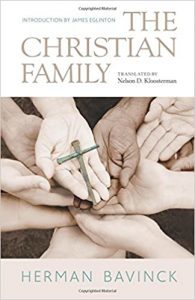 1. Herman Bavinck, The Christian Family (Christian’s Library Press, 2012)
1. Herman Bavinck, The Christian Family (Christian’s Library Press, 2012)
Big Idea: “The human nature given to man and woman is one and the same, but in each of them it exists in a unique way. And this distinction functions in all of life and in all kinds of activity” (68).
Audience: Thoughtful Christian, especially good for pastors.
Bottom Line: While some people may find Bavinck’s assumptions dated here or there, on the whole this is a tremendous work, providing a robust theology of the family and a necessary corrective to contemporary notions that would have us believe there is neither a manly nor a womanly way to follow Christ.
 2. David Walton, The Genius Plague (Pyr, 2017)
2. David Walton, The Genius Plague (Pyr, 2017)
Big Idea: A science-fiction book about a mushroom plague from the Amazon that invades its human hosts, giving them heightened intelligence and nefarious instinct to take over everyone and everything in its path.
Audience: Any reader, teenage or older.
Bottom Line: I heard Phil Ryken recommend this book as one he couldn’t put down. I agree. While the theme of a global plague may not be your cup of tea at the moment, Walton tells a fast paced story that grips you from start to finish.
 3. Thomas J. DiLorenzo, The Problem with Socialism (Regnery, 2016)
3. Thomas J. DiLorenzo, The Problem with Socialism (Regnery, 2016)
Big Idea: “This book will serve as a primer on socialism (and capitalism) for some; a historical reminder for others; and a handy sourcebook on all the problems of socialism and how it threatens a free society” (12).
Audience: General.
Bottom Line: Written by a professor of economics at Loyola University (MD), the title tells you what to expect. The book will probably do more to reinforce the already convinced than to persuade those on the other side.
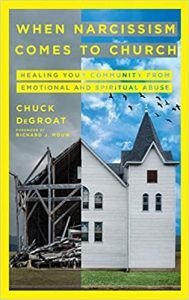 4. Chuck DeGroat, When Narcissism Comes to Church: Healing Your Community from Emotional and Spiritual Abuse (IVP, 2020)
4. Chuck DeGroat, When Narcissism Comes to Church: Healing Your Community from Emotional and Spiritual Abuse (IVP, 2020)
Big Idea: “Narcissism is born in the soil of shame and self-contempt, not healthy self-love. Narcissism is not fundamentally about self-love but about an escape from love. The fragile little boy goes into hiding and the protective false self takes the lead” (30).
Audience: Popular-level book for a Christian audience.
Bottom Line: This book hits on an all-too-real problem in the church. DeGroat’s description of emotional and spiritual abuse will sound familiar to many people. Unfortunately, I found the book much better at description than prescription, the latter of which consists in a psychological framework rooted in Thomas Merton, Carl Jung, Richard Rohr, and the Enneagram.
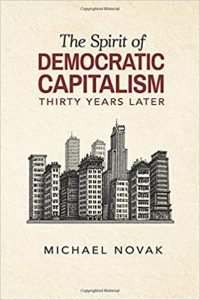 5. Michael Novak, The Spirit of Democratic Capitalism Thirty Years Later (Institute for Faith, Work, and Economics, 2015)
5. Michael Novak, The Spirit of Democratic Capitalism Thirty Years Later (Institute for Faith, Work, and Economics, 2015)
Big Idea: “Universal wealth is best created not by slavery or serfdom, and not by governmental direction from the top down, but by free women and free men using their own inventive and industrious minds to serve the largest public they can reach” (9).
Audience: This is a short pamphlet of a book (35 pages) for a general audience.
Bottom Line: A useful recapitulation (or re-introduction) of several key themes from Novak’s seminal book, The Spirit of Democratic Capitalism (1982).
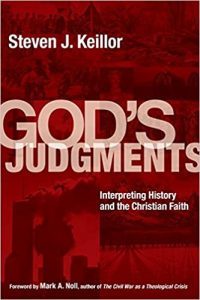 6. Steven J. Keillor, God’s Judgments: Interpreting History and the Christian Faith (IVP Academic, 2012)
6. Steven J. Keillor, God’s Judgments: Interpreting History and the Christian Faith (IVP Academic, 2012)
Big Idea: “The basic idea of this book—that we must return cautiously and accurately to the concept of God’s judging activity in history as central to Christianity—emerges partly out of the inadequacy of other ideas” (18).
Audience: This is an academic book written by a trained historian, but the content is accessible to an educated audience.
Bottom Line: Keillor convincingly argues that Christianity is an interpretation of history and that as the Christian interprets history we should dare to see God’s judgments as central to it. And yet, while I found this central theme persuasive, I was not persuaded by Keillor’s attempts to provide concrete explanations for specific divine judgments in history (e.g., 9/11, the burning of Washington).
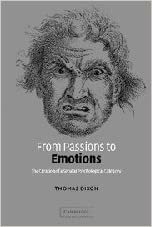 7. Thomas Dixon, From Passions to Emotions: The Creation of a Secular Psychological Category (Cambridge University Press, 2003)
7. Thomas Dixon, From Passions to Emotions: The Creation of a Secular Psychological Category (Cambridge University Press, 2003)
Big Idea: The notion that “emotions are physiological, non-cognitive and involuntary feelings” are “all ideas that gained currency as a result of divergence from traditional teachings about the ‘passions’ and ‘affections’ and the concomitant adoption of the secular category of ’emotions’ in the nineteenth century” (14).
Audience: Academic, helps to have a working knowledge of major thinkers from the 18th and 19th centuries.
Bottom Line: This important book shows how theology, psychology, and the way we talk about human experience is worse off for having the older categories of passions, affections, and sentiments collapsed into the modern category of emotions. Theologians and pastors should read this book (or at least read the first couple chapters on Augustine and Aquinas).
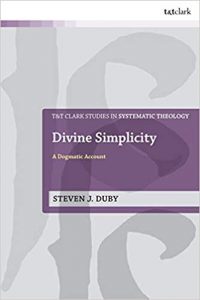 8. Steven J. Duby, Divine Simplicity: A Dogmatic Account (T&T Clark, 2016)
8. Steven J. Duby, Divine Simplicity: A Dogmatic Account (T&T Clark, 2016)
Big Idea: Simplicity is “a divine attribute rooted in Holy Scripture’s portrayal of God in his singularity, aseity, immutability, infinity and work of creation ex nihilo. In other words, this is not an iteration of the project of ‘perfect being’ theology, but rather an exercise in Christian dogmatics, setting forth the content of exegesis in an elaborative, discursive manner, and then identifying implications for divine simplicity” (2).
Audience: Academic, not going to meet the lay reader halfway.
Bottom Line: An impressive exploration and defense of divine simplicity, with scholarly chops on display in exegesis, philosophy, and dogmatics.
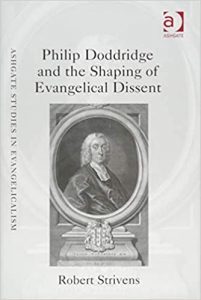 9. Robert Strivens, Philip Doddridge and the Shaping of Evangelical Dissent (Ashgate, 2015)
9. Robert Strivens, Philip Doddridge and the Shaping of Evangelical Dissent (Ashgate, 2015)
Big Idea: “Philip Doddridge has been rightly presented in the secondary literature as influenced significantly by John Locke in his philosophy and by Richard Baxter in his theology and spirituality.” This is not incorrect. But Strivens argues that Doddridge’s “appropriation of Baxter and of Locke has been shown to have been nuanced and influenced in important areas by other significant Puritan and Calvinist elements” (162).
Audience: Academic, but clearly written and well organized.
Bottom Line: While the book is written with specialists in mind, pastors and other students of Christian history would do well to know more about one of the most important evangelicals in the first half of the 18th century.
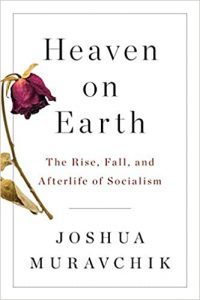 10. Joshua Muravchik, Heaven on Earth: The Rise, Fall, and Afterlife of Socialism (Encounter Books, 2019)
10. Joshua Muravchik, Heaven on Earth: The Rise, Fall, and Afterlife of Socialism (Encounter Books, 2019)
Big Idea: Written by the son of communists, this book is an intelligent and readable history of socialism told through a series of biographical vignettes. If Muravchik is subtly critical of socialism, it is only because the history of socialism’s leaders and experiments have so much to be objectively critical of.
Audience: General interested reader.
Bottom Line: Before reading a book on economics for or against socialism, I would read this book on the origins and historical development of one of the world’s most consequential ideas over the last 250 years.
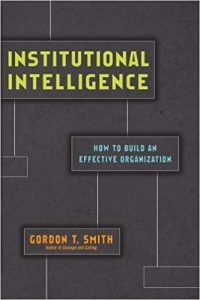 11. Gordon R. Smith, Institutional Intelligence: How to Build an Effective Organization (IVP Academic, 2017)
11. Gordon R. Smith, Institutional Intelligence: How to Build an Effective Organization (IVP Academic, 2017)
Big Idea: “Pastors need to be encouraged to view the work of administration not as a necessary evil, a distraction, but as rather an integral part of what it means to provide congregational leadership” (8).
Audience: Popular-level book aimed at pastors, presidents, board members, and anyone who has a role to play in the fidelity of effectiveness of institutions.
Bottom Line: Most pastors and Christian leaders don’t give enough time developing institutional intelligence. This book is a wonderful remedy to this common gap in our discipleship. A wise and practical book.
 12. George M. Marsden, Jonathan Edwards: A Life (Yale University Press, 2003)
12. George M. Marsden, Jonathan Edwards: A Life (Yale University Press, 2003)
Big Idea: “Edwards was extraordinary” (1). And yet, we must get to the person behind the monuments. “In writing this life of Edwards, one of my goals has been to understand him as a real person in his own time” (2).
Audience: This is a lifetime of scholarship written with such command of the material and with such ease as to make the book accessible to a wide audience.
Bottom Line: I read the shorter version by Marsden years ago and read parts of this magisterial biography here and there, but I never read the whole thing until now. It lived up to the hype. Truly, one of the best biographies you can read.
March 18, 2020
The Coronavirus Is a Result of the Fall

Since the world was seemingly turned upside down a week ago by the coronavirus, Christianity Today has published a number of helpful articles—some theological, some practical, and some medical. We need outlets like CT to provide thoughtful reflection during these tumultuous times.
But yesterday’s editorial by Daniel Harrell, CT’s new editor-in-chief, was baffling.
The basic gist made sense: take heart, love God, and love one another. But to get to that conclusion, Harrell made some curious claims. Let me briefly mention three.
First, Harrell insists that COVID-19 “is not a ‘foreign virus’ but endemic to our common nature as humans and thus a means of drawing us together for the good of all.” Setting aside the fact that the virus undeniably originated in China—which is, of course, no reason to mistreat our Chinese neighbors—the rest of the sentence invites questioning. By “common nature” does Harrell mean our common human nature as given by God? If so, how is a killer disease endemic to that nature? If he means our common fallen nature, how do the two halves of the sentence advance more than a tautology? Of course, coming together in a crisis is good (though in this instance not literally coming together). But you could just as logically say “lying is endemic to our common nature” or “idolatry is endemic to our common nature” and thus lying or idolatry or anything that humans have in common is a means for drawing us together.
Second, Harrell argues that the reason for suffering in the world is explained by God’s inviolable commitment to human free will. Harrell extends this familiar argument further to the natural world, suggesting that the sea and the land have a kind of free will too. If human free will means freedom from external coercion and compulsion (and that is a meaningful kind of freedom) then humans are certainly free. But even if one does not accept a Reformed view of divine sovereignty, it must still be acknowledged that when the Bible stares into the depths of human suffering it does not come out the other side extolling human free will. When calamity fell upon Job he could have rightly pointed to the activity of the Sabeans, the Chaldeans, fire that fell from the sky, a great windstorm, or even Satan himself. But Job’s cry was undeniably theocentric: “The LORD gave, and the LORD has taken away; blessed be the name of the LORD” (Job 1:21). The one explanation Job never countenanced during his whole, terrible ordeal was that natural and anthropological freedom were the answers to his heartbreaking questions. Job never imagined that God was not superintending the tragic events of his life.
Third, and most perplexing, Harrell seems to answer the title of his editorial, “Is the Coronavirus Evil?” with a firm “no.” Harrell explicitly rejects Barth’s contention that the bacillus attacking his (Barth’s) body late in life was a monstrosity that did not belong to God’s good creation. In contrast to Barth, Harrell argues that bacteria and viruses are among the first fruits of God’s good creation and that organic death existed before the fall. Furthermore, Harrell maintains that it is “Better to view creation not as something perfect gone awry, but as something begun as very good only not yet finished.” What should we make of these claims?
For starters, Harrell is right that bacteria and viruses as such were likely a part of God’s good design for an intricately ordered creation. We know from microbiology that bacteria play an integral role in sustaining life on the planet and that viruses contribute to the functionality of these bacterial agents. There is no problem in affirming that bacteria and viruses per se are not evil.
Likewise, let’s set aside the question of whether organic death (of some kind) existed before the fall. I believe that death is a result of the fall, which is one reason I believe in a young earth. But many orthodox theologians have held that the death of plants and animals occurred before the fall of Adam and Eve. So again, if Harrell’s argument were simply that God made bacteria and viruses, and that plants decayed and lions chased gazelles before the fall, those would be unremarkable statements.
But he is arguing more than that. Harrell maintains that when God looked over his creation on the sixth day and declared it very good, he meant that creation was not yet finished. To be sure, mankind was given a task to subdue the earth, to build “culture” as it were. In that sense, there was work to be done. But the work was man’s to be done in the created realm. There’s no sense in which “very good” can mean the divine work of creation was incomplete.
Most concerning, Harrell implies that the coronavirus is not evil, that a respiratory illness that may kill millions of human beings is not the result of creation gone awry. If Harrell wants to put in a good word for bacteria and viruses, so be it. But his post is about the coronavirus. A rogue virus already inflicting illness and death upon thousands is impossible to square with the depiction of creation as “very good” (Gen. 1:31).
Here, for example, is how Matthew Henry’s commentary describes the goodness of God’s creation at the close of the sixth day:
It was good. Good, for it is all agreeable to the mind of the Creator, just as he would have it to be. Good, for it answers the end of its creation, and is fit for the purpose for which it was designed. Good, for it is serviceable to man, whom God had appointed lord of the visible creation. Good, for it is all for God’s glory. (The Matthew Henry Commentary, 5)
Or consider Calvin’s description:
After the workmanship of the world was complete in all its parts, and had received, if I may so speak, the last finishing touch, he pronounced it perfectly good; that we may know that there is in the symmetry of God’s works the highest perfection, to which nothing can be added. (Commentary on Genesis, 100)
Later in the same work, Calvin explains the effects of the fall on the created world. His description is not a unique Reformed reading of the text, but a mainstream understanding of what it means for human beings to make their way in a world that is not the way it’s supposed to be.
Before the fall, the state of the world was a most fair and delightful mirror of the divine favour and paternal indulgence toward man. Now, in all the elements we perceive that we are cursed. . . . The earth will not be the same as it was before, producing perfect fruits; for he declares that the earth would degenerate from its fertility, and bring forth briers and noxious plants. Therefore, we may know, that whatsoever unwholesome things may be produced, are not natural fruits of the earth, but are corruptions which originate from sin. (173-74)
Could viruses have existed in Genesis 1? Sure. Do fatal viruses exist prior to the events of Genesis 3? Of course not. Water was God’s good creation; the flood was the result of sin. It makes much better sense to attribute a rogue virus not to the supposed incompleteness of God’s very good creation, but to the “thorns and thistles” that now grow up in a fallen world (Gen. 3:18), part of the futility to which the creation has been subjected in its bondage to corruption (Rom. 8:20-21).
The coronavirus is a natural evil, under God’s providential control to be sure, but whose existence is the result of original sin. The root of all human pain and suffering in the world is the rebellion of our first parents—a rebellion that Christ conquered on the cross and will one day wipe away, along with all its sad and sinister effects.
March 13, 2020
All Things from His Fatherly Hand

As the Lord’s providence would have it, last Sunday—the Sunday before everyone and everything seemed to be taken over by COVID-19—was Lord’s Day 10. If you’ve ever used the Heidelberg Catechism you know the 129 questions and answers are given over 52 Lord’s Days. Week 10 is about providence.
Q. What do you understand by the providence of God?
A. Providence is the almighty and ever present power of God by which he upholds, as with his hand, heaven and earth and all creatures, and so rules them that leaf and blade, rain and drought, fruitful and lean years, food and drink, health and sickness, prosperity and poverty—all things, in fact, come to us not by chance but from his fatherly hand (Heidelberg Catechism Q/A 27).
This is my favorite Lord’s Day in the entire Catechism. I love its poetic description of providence. “Sovereignty” is the word we hear more often. That’s a good word too. But if people run out of the room crying whenever you talk to them about sovereignty, try using the word “providence.” For some people God’s sovereignty sounds like nothing but raw, capricious power: “God has absolute power over all things, and you better get used to it.” That kind of thing. And that definition is true in a sense, but divine sovereignty, we must never forget, is sovereignty-for-us. As Eric Liddel’s dad remarked in Chariots of Fire, God may be a dictator, but “Aye, he is a benign, loving dictator.”
Coming to grips with God’s all-encompassing providence requires a massive shift in how we look at the world. It requires changing our vantage point—from seeing the cosmos as a place where man rules and God responds, to beholding a universe where God creates and constantly controls with sovereign love and providential power.
The definition of providence in the Catechism is stunning. All things, yes all things, “come to us not by chance but from his fatherly hand.” In my previous denomination, I used to ask seminary students being examined for ordination, “How would the Heidelberg Catechism, particularly Lord’s Day 10, help you minister to someone who just lost a job or a child, or just received a frightening diagnosis?” I was often disappointed to hear students who should have been affirming the confessions of their denomination shy away from Heidelberg’s strong, biblical language about providence.
Like most of us, the students were much more at ease using passive language about God’s permissive will or comfortable generalities about God being “in control” than they were about stating precisely and confidently to those in the midst of suffering “this has come from God’s fatherly hand.” And yet, that’s what the Catechism teaches.
And more importantly, so does the Bible.
To be sure, God’s providence is not an excuse to act foolishly or sinfully. Herod and Pontius Pilate, though they did what God had planned beforehand, were still wicked conspirators (Acts 4:25-28). The Bible affirms human responsibility. It also affirms comprehensive divine sovereignty. Prudence, yes. Precautions, yes. And providence, a thousand times yes.
The Bible also affirms, much more massively and frequently than some imagine, God’s power and authority over all things.
The nations are under God’s control (Psalm 2:1-4; 33:10), as is nature (Mark 4:41; Psalm 135:7; 147:18; 148:8), and animals (2 Kings 17:25; Dan. 6:22; Matt. 10:29).
God is sovereign over Satan and evil spirits (Matt. 4:10; 2 Cor. 12:7-8; Mark 1:27).
God uses wicked people for his plans—not just in a “bringing good out of evil” sort of way, but in an active, intentional, “this was God’s plan from the get-go” sort of way (Job 12:16; John 19:11; Gen. 45:8; Luke 22:22; Acts 4:27-28).
God hardens hearts (Ex. 14:17;Josh. 11:20; Rom. 9:18).
God sends trouble and calamity (Judg. 9:23; 1 Sam. 1:5; 16:14; 2 Sam. 24:1; 1 Kings 22:20-23; Isa. 45:6-7; 53:10; Amos 3:6; Ruth 1:20; Eccl. 7:14).
God even puts to death (1 Sam. 2:6, 25; 2 Sam 12:15; 2 Chr. 10:4, 14; Deut. 32:39).
God does what he pleases and his purposes cannot be thwarted (Isa. 46:9-10; Dan. 4:34-35).
In short, God guides all our steps and works all things after the counsel of his will (Prov. 16:33; 20:24; 21:2; Jer. 10:23; Psalm 139:16; Rom. 8:21; Eph. 1:11).
It’s worth noting that Lord’s Day 10 is explaining what the Apostles’ Creed means when it says, “I believe in God, the Father almighty, creator of heaven and earth.” If God is the creator of all things and truly almighty, then he must continue to be almighty over all that he has created. And if God is a Father, then surely he exercises his authority over his creation and creatures for the good of his beloved children. Providence is nothing more than a belief in “God the Father almighty, creator of heaven and earth” brought to bear on our present blessings and troubles and buoying our hope into the future.
You can look at providence through the lens of human autonomy and our idolatrous notions of freedom and see a mean God moving tornadoes and influenza like chess pieces in some kind of perverse divine play-time. Or you can look at providence through the lens of Scripture and see a loving God counting the hairs on our heads and directing the sparrows in the sky so that we might live life unafraid.
“What else can we wish for ourselves,” Calvin wrote, “if not even one hair can fall from our head without his will?” There are no accidents in your life. Nothing has been left to chance. Every economic downturn, every novel virus, every oncology report has been sent to us from the God who sees all things, plans all things, and loves us more than we know.
As children of our heavenly Father, divine providence is always for us and never against us. Joseph’s imprisonment seemed pointless, but it makes sense now. Slavery in Egypt makes sense now. Killing the Messiah makes sense now. At some point in the future—whether near or far—the coronavirus will make sense. Whatever difficulty or unknown we may be facing today, it will make sense someday—if not in this life, then certainly in the next.
We all have moments where we fear the unknown. The fact of the matter is our worries may come true, but God will never be untrue to his us. We don’t know what the future holds, but we do know who holds the future. God will always lead us, always listen to us, and always love us in Christ.
God moves in mysterious ways; we may not always understand why life is what it is. But we can face the future unafraid because we know that nothing moves, however mysterious, except by the hand of that great Unmoved Mover who moves all and is moved by none, and that this Mover is not an impersonal force but the God who is our Father in heaven.
March 10, 2020
Sympathy Is Not the Point

One of the marks of the confusion of our age is that we have come to value feeling the right thing over doing the right thing.
That actually may be giving the current mood too much credit. It would be nearer the truth to say we value professing to feel the right thing over doing the right thing. We live in an age of sentimentality where feeling the joys, or particularly the pains, of another (or at least expressing that we do) is considered virtuous in itself.
But surely sympathy, while often commendable, is not the main point.
Lesson from Christology
This was brought home to me recently while reading William Shedd’s treatment of Christ’s temptations and impeccability. It is sometimes argued that being “tempted in every way just as we are” (Heb. 4:15) means Christ experienced the exact temptations we face in the exact way we face them. But Christ was never tempted to spend too much time on an iPhone or to give his wife the cold shoulder. Jesus didn’t face precisely the same temptations we face.
More importantly, he didn’t face temptation in the same way. Our temptation is often tainted with sin, arising within us as an expression of original or indwelling sin. Christ could not experience temptation just as we do and still be a sinless Savior. What Hebrews means instead is that Christ knew the kinds of weaknesses, sufferings, and afflictions we know. “In order to sympathize with a person,” Shedd writes, “it is not necessary to have the exact same affliction that he has. It is only necessary to have been afflicted” (Dogmatic Theology, 669). And Christ was certainly afflicted in suffering and in temptation. We may not know the internally psychology of our impeccable Savior as he was tempted, but he was genuinely tempted, even if the temptation did not arise within him, like ours often does, from the power of indwelling sin. Christ can sympathize with afflicted human beings because he too was afflicted.
The good news in having a sympathetic high priest is not that Christ sprained his ankle as many times as I’ve sprained my ankle, nor is the good news more generally that Christ continues to hurt when we hurt (let alone that God suffers when we suffer). No, the good news in having a theanthropic person in heaven—the God-man—who knows our weaknesses is that we can, therefore, with confidence draw near to the throne of grace, that we may receive mercy and grace in time of need (Heb. 4:15-16).
It is a glory beyond measure that the incarnate and perpetual God-man is able to sympathize with our weakness, but sympathy itself is not the point (interestingly, the text doesn’t say he sympathizes with us, but with our weaknesses). The point is that because of the Son’s identification with his brothers he can help us. Surely, it’s significant that the two great Christological identification passages in Hebrews—chapter 2 and chapter 4—conclude with the reassurance that our faithful high priest will help us (Heb. 2:18; 4:16). The emphasis is not on Jesus feeling the right thing in heaven. Rather, the good news is that because he has felt what we felt, he will surely come to our aid. The doctrine of our sympathetic Savior should not be construed as the triumph of sentimentality.
What Is Love?
Of course, understanding Christ’s love for us has ramifications for how we understand that nature and exercise of Christian love for others. To be clear, sympathy can be a very good thing, but it is good because of what it may prompt. That may seem a harsh judgment, but consider: if Sam is sick and Andy hears about it and, unknown to Sam, cries himself to sleep every night over Sam’s predicament, how is Sam helped? The mere experience of sympathy with suffering does not by itself help the sufferer. That doesn’t mean sympathy is nothing. When Andy’s sympathy moves him to send a text or bring over a home-cooked meal, that will mean something to Sam. If a stranger feels what I feel and I never know about, the stranger’s experience of sympathy may make him feel better, but it has no effect on me. What helps is the movement that sympathy makes toward the person. It’s the word of comfort, the gesture of kindness, the written card that helps. Doing the right thing matters more than feeling the right thing. Again, Shedd puts it well: “The strength and reality of sympathy are seen in the amount of self-sacrifice that one is willing to make for the miserable, rather than in the mere fact that one has felt precisely the same misery himself” (669).
In other words, sympathy may lead to the tangible exercise of the Spirit’s fruit, but it is not by itself the work of the Spirit. While it requires an unusual cruelty to be completely indifferent to the sufferings of others, it does not require a work of the Spirit to feel sorry for people. There’s a reason that reality shows and sporting events like to provide sad back stories for athletes and contestants. Sympathy is a relatively easy emotion to come by—especially in the age of social media where such expressions are a click away. That makes sympathy a powerful ally in doing the right thing. It also makes sympathy easily manipulated so that people do the wrong thing based on what seems to be a right feeling or simply conclude they have already done the right thing by feeling what they feel (or at least saying that they do).
Rejoicing and Weeping
What about Romans 12:15, you may ask. There we are told to “rejoice with those who rejoice” and “weep with those who weep.” Isn’t this basically a command to sympathize with others?
Yes and no.
For starters, consider the inherent difficulty in being obligated to feel happy every time you are around happy people and to feel sad every time you are around sad people. In such an arrangement, no doctor could care for sick people or counselor work with the grieving. Neither, for that matter, could hurting people throw birthday parties for children. Paul’s instruction is not an absolute command to have chameleon-like feelings.
Surely, the saying is a type of proverb, a maxim, a saying of virtuous wisdom. The point is not to train your emotions to match every emotion you encounter, but rather to be a thoughtful, considerate person who doesn’t sing a dirge at a wedding or bring a kazoo to a funeral. I remember after the last presidential election hearing some Christians say that other Christians were obliged to weep with them as they grieved the outcome of the election. Romans 12:15, it was said, commanded others to share in their sorrow. But of course, on that application, Christians were also obligated to celebrate with those who cheered the results of the election.
I’m not suggesting Romans 12:15 had no application in that moment. No doubt, Christian maturity, if not basic human decency, would suggest that we would all be wise to remember that others may not have felt the same way we did. Love is not rude, which means obnoxiously mismatching the mood of those around you is quite often a sin. But Romans 12:15 is less about feeling the right thing than about maintaining the warmth and unity of Christian fellowship. That’s why verse 15 is followed by commands like “live at harmony with one another” (v. 16), “do not be haughty” (v. 16), “do what is honorable,” (v. 17), and “so far as it depends on you, live peaceably with all” (v. 18). Raining on parades and dancing at gravesides does not help keep the peace.
Doing Over Feeling
Why all these musings on sympathy? Because I believe too many Christians share our culture’s preference for feeling over doing. Listen, I’m not against feelings—Dutchman though I am! I think I live my life with a healthy range of emotions. What’s more, many of the right things to be done are prompted and motivated by our emotions. But feelings are not infallible. Sensitivity is one thing, sacrosanct is another. I am always responsible for what I do; I am not always responsible for how you feel. If emotional ineptitude is a problem for some, then emotional blackmail is for others.
We too quickly attach exalted praise to easy expressions of sympathy. And on the flip side, we rush to judge those who may be quietly acting the part of a good neighbor in private but do not loudly profess the right sympathy in public. We demand of people proper emoting, and when they don’t oblige we condemn them more harshly for what we think they have not felt than for what they did or did not do. The internet exacerbates these tendencies. We are more aware of human suffering around the world than ever before, and likewise we are asked to express sympathy—often from strangers and often for strangers—in quantities that outstrip realistic human capacity.
And yet, the Bible never says “the greatest of these is sympathy.” Love may be related to sympathy at times, but it is far from identical. Just look at our Lord who was known to feast when others were fasting and ask impertinent questions when blood was spilled and towers fell. There are higher virtues than feeling what others feel and higher callings than legitimizing the emotional opinions of others. We have made sentimentality our chief moral duty, when cheap would be the more operative word.
February 25, 2020
7 Questions to Ask in Evaluating Online Pundits

One of the best things about the internet is that anyone can state his opinion about anything.
And one of the worst things about the internet is that anyone can state his opinion about anything.
The digital revolution has made knowledge more accessible, the flow of information more diverse, and the ability to make your voice heard easier than ever.
The same revolution has also made invincible ignorance more sustainable, pervasive crankery more common, and the ability to discern what voices are worth listening to harder than ever.
There’s no putting the genie back the bottle. Even if more news and punditry is being “curated” these days, it’s still the case than anyone with a strong opinion and the self-discipline (or blinding rage, the case may be) to blog and tweet and post consistently can command a following and wield a level of influence that would have been unthinkable twenty years ago. If we are to be wise, then, in both what we read online and how we read it, we need to stand by the unpopular conclusion that not all opinions are created equal.
In his book The Death of Expertise, Tom Nichols tells the story of an undergraduate student arguing with a renowned astrophysicist who was on campus to give a lecture about missile defense. After seeing that the famous scientist was not going to change his mind after hearing the arguments from a college sophomore, the student finished in a harrumph, “Well, your guess is as good as mine.” At which point the astrophysicist quickly interjected, “No, no, no. My guesses are much, much better than yours” (82–83). Just because someone is confident, doesn’t mean he is anywhere close to correct.
So how do we evaluate the cacophony of punditry around us, especially the online variety? Few of us have time to research every author we read, let alone the subject matter on which they are pontificating. In most of life, it serves us well to assume that people are telling us the truth. Without knowledge of the inner workings of a church or school or institution, it can be hard to tell what’s factually accurate and what’s a false allegation. Sifting truth from error in an online world is no easy task.
But there are several common sense questions we can run through our brains before giving undue credence to the latest and loudest opinions.
1. Does this person inhabit a healthy web of family and friends? Of the questions listed here, this is the hardest to answer. Often, we won’t know anything about the person we are reading online. But at times, we may be able to discern something of a relational pattern, for good or ill. To be sure, even nasty folks can find a friend or two, and sometimes the best people suffer through family drama not of their own making. And yet, as a general rule, if I know someone has a good marriage, a happy home life, a lot of supportive friends at church and at work, and a long track record of strong relationships, I’m more inclined to hear what he has to say, especially on spiritual matters. Conversely, I’m less likely to consider someone an expert on spiritual matters who is surrounded by a train of relational wreckage with himself at the center. We are whole people, and those who are emotionally unhealthy and unstable are not usually the best go-to guides for fair analysis and discernment.
2. Does this person have full-time responsibilities beyond independent punditry? Again, there are exceptions. Tim Challies, for example, has proven to be one the most trustworthy and reliable voices on the internet. He made his name as an independent blogger and has kept up the good work for years. But he’s the exception that proves the rule. When I read some people online I can’t help but think, “What do you actually do for a living?” I’m not talking about full-time moms either. I’m talking about people who don’t seem to be running a church, running a business, running a family, or punching in regular hours to pay the bills. If you mainly hang-out online responding to every mention on Twitter, provoking your opponents, fishing for compliments, and getting into digital fights every few days, I wonder if you have the real-world maturity and perspective to be helpful. I take inveterate pugilists and narcissists with a massive grain of salt.
3. Does this person have the commensurate education or experience that makes them worth listening to? Yes, I know the talk of academic degrees can sound hopelessly elitist. There are plenty of dumb smart people in the world. But when it comes to real expertise, there is a big difference between someone who has taken years or decades to become acquainted with a subject and someone who has been looking into a given person, place, or thing for a few weeks (or minutes!). I prefer to listen to people who know more than I do, not simply emote their convictions more strongly.
4. Is this person held accountable by any meaningful institutions? When it comes to public controversy, institutions are always at a disadvantage. A lone blogger or tweeter can make allegations, respond to comments, and be single-minded in his effort to expose what he sees as corruption or error in a church, school, organization, or business. And sometimes, we need these whistle blowers to see what everyone refuses to see. Institutions do make mistakes; they can become corrupt. But lone wolves can make mistakes and be corrupt too. And when they are, the institutions they oppose are at a profound disadvantage. An individual can post and respond with relative impunity. Institutions have to move slowly and cautiously. They have boards and employees and constituencies to think about, not to mention financial and legal ramifications. This doesn’t mean that belonging to an institution makes one right, but I generally feel more confident about someone who is actively involved in and accountable to a church, a session, an employer, a school, a board, a presbytery, or some combination thereof, than I do about someone whose performance, ideas, and behavior reflect on no one but himself.
5. Does this person provide the necessary links and citations to bolster his assertions? Fairly often, I will have people in my church ask about articles and allegations they read online. Usually, the accusations involve people they thought they could trust, but now appear to be mixed up in some nefarious underworld. Almost always, the accusations brought to my attention come from those (the online source, not the people in my church) who provide no hard facts to substantiate their slanderous claims. When links are provided, they are often nothing more than elaborate attempts at guilt by association. The click bait is usually the product of hearsay, half truths, and an eagerness to believe the worst about people. Or else the most serious charges are based upon unproveable and ambiguous accusations about Illuminati-like conspiracy theories. Likewise, just the mere recitation of a claim does not make it true. If I assert that Organization X is funded by blood money, and Leader Y is a closet Zoroastrian, and Institution Z drowns puppies behind closed doors, those claims are no more true because I repeat them and no more tied to facts because other people start to assume them to be true.
6. Does this person express his opinions and state his case with a due sense of proportion? This rule of thumb will serve you well: don’t believe hysterics. If the matter at hand is truly grave, the facts should speak for themselves. Or if we must use hard words, make sure they are in conjunction with even firmer arguments. When everything in one’s public profile is a five alarm fire, I tend to think the pundit is interested in starting fires more than in putting them out.
7. Does this person exhibit any interest in trying to understand the arguments of others or speak carefully about those he means to criticize? I can learn a lot from people who try to persuade. I learn little from people who do nothing but berate. When a writer, thinker, or critic never sees any good points on the other side, or never sees any trade-offs in his own position, I question his commitment to intellectual rigor. Likewise, when a pundit always–forever and ever, amen–finds fault in people to the left of him or only in people to the right of him, it makes me think the punditry is about party loyalty more than a honest search for truth.
Granted, these tests aren’t foolproof. There are exceptions to all these “rules.” But rarely does someone break all (or most) of these “rules” and prove to be a trustworthy voice. We owe it to our families, our friends, our churches, and to ourselves to think critically before we take in gossip, pass along slander, or simply succumb to logical nincompoopery and ill-founded bloviating passed off as courage.
Update: 7 Diagnostic Questions for My Writing Life (drafted by Samuel James)
1. How is the current quality of my relationship with my wife, children, friends, church members, and coworkers? Do these relationships lend legitimacy to my perspective or raise questions about my character?
2. Am I being faithful to my day-to-day vocation? Do my effort and focus at work lend credibility to my writing, or would they undermine it if readers could see my week?
3. Am I consistently speaking to areas in which I have valuable knowledge and experience? Am I regularly going “outside my lane” simply to get clicks/follows?
4. Am I saying anything that could damage the reputation of my employer or my church? Would I quietly prefer if these people didn’t read what I’m writing?
5. Do I take the time and effort to educate myself on topics so that I can point others toward credible resources? Am I trying to generate content more than I’m trying to generate knowledge?
6. Am I investing time and energy in issues that really matter? Do I easily get distracted by “conversations” that nobody will even remember next week?
7. Am I teachable and open to correction? Do I try to convince people or defeat them?



